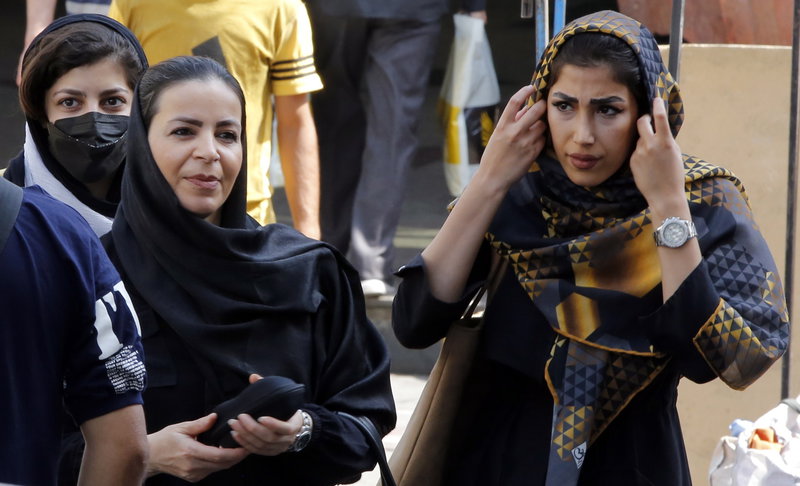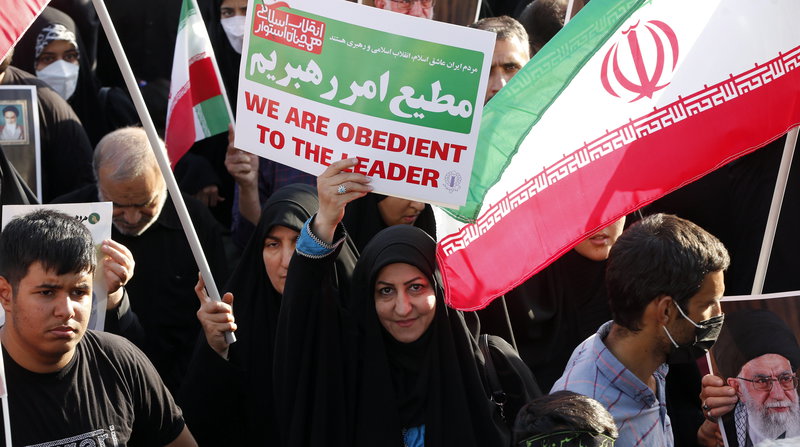Iranian women say enough
Iran is submerged in unrest as thousands take to the streets to protest the police killing of Masha Amini for not wearing her veil correctly
In Iran, more and more women are cutting their hair in public. The white and green vans that roam the big cities continue to cause fear, but the women come together and receive the support of the crowds. They confront the police, knock over the vehicles of the security forces and show their loss of respect for the very authorities that make their lives impossible. These days, women with hair exposed to the wind and others who choose to cover themselves with the hijab join together to fight the regime in protests that are gaining strength and support by the day.
The reaction first erupted in the Kurdish region of northern Iran through the chants of this ethnic minority. The women of Saqqez began to remove their veils in public and shout “women, life and freedom” as soon as the death of Masha Amini, a resident of the city, became known. The young woman was visiting Tehran when security forces attacked her for wearing the veil incorrectly. The brutality of the arrest left Amini in a coma and in hospital, where she eventually died.
Today, the proclamations of Kurdish women can be heard throughout Iran. Amini’s murder is the case that has extended the current cycle of protests across the country, in which thousands of women have had enough of being terrified by the “morality police”, the police authority that patrols the streets chasing women who do not comply with the aesthetics imposed by the Ayatollahs. Their job is to ensure that women have their hair well covered, are not wearing a lot of make up and not wearing tight-fitting clothes.
The protests have become a threat to the entire Iranian regime, which has chosen to respond with an iron fist. Among the multiple violations of human rights against their own citizens, more than a hundred dead and dozens of missing stand out.
Enemies of the authorities
The wildest protests of an entire generation come as a response to decades of control and repression, with women as the main victims. The imposition of the hijab since the Islamic Revolution of 1979 is only a small part of a story that is getting worse. Iranian president Ebrahim Raisi last month announced that the Revolutionary Guards would begin using facial recognition technology to prosecute women who did not abide by the rule. These cameras, located in the streets and on the underground, make it possible for the authorities to hunt down offenders and sentence them with up to 10 years in prison. “Every time I leave home, I’m terrified,” said one telecommunications company employee speaking to Reuters in Tehran: “These cameras are everywhere.”
This humiliation of women encompasses all spheres of life. The regime has warned that those who appear on social media with their hair uncovered may be fined and lose their jobs. Some women have been forced to apologise on national television after being jailed by the morality police. Those arrested cannot be released until they are collected by a legal guardian, who in all cases must be a man from their family.
“I support these protests and I’m not exaggerating when I say everyone I know does,” says Marjan, an Iranian from Tehran, where she lived a good part of her life. She is now 35 years old and resides in the United States, escaping the isolation to which Iranian authorities condemn their citizens. The internet outages that the regime has recently imposed to contain the riots behind closed doors also make it difficult to maintain contact with sources on the ground. “I spent a year and a half in Iran in 2019 and felt there would be a feminist revolution soon; the force of the repression was enormous,” Marjan says. This economist by profession, who left the country because there were things she could not accept “from a misogynistic regime”, explains that young people are leading the protests: “They are fed up with it, because they know that life in the rest of the world is not like in Iran. They look around and want to live better,” she says.
The renowned activist Hoda Katebi uses similar terms to express herself, also from the United States: “As an Iranian American who chooses to wear the hijab, I am enraged by the way the Iranian state exploits my identity to maintain power,” Katebi writes: “This is not about Islam or applying morality, but about imposing the power of the state.”
The increase in repression has come at the hands of Ebrahim Raisi, who has held the post of president of the country since June last year, when he won an election that seemed fabricated to pave his way to power. The Supreme Leader of the Persian nation, Ayatollah Ali Khamenei, vetoed all nominations not part of the ultraconservative platform. The rejection of renowned figures and acceptance of candidates of mediocre reputation seemed to be, in the eyes of many voters, a strategy to catapult Raisi, a cleric with a traditionalist profile close to the Supreme Leader, to power.
Raisi’s trajectory is stained with blood. The current Iranian president had previously held multiple positions in the judicial system. When Khamenei himself appointed him leader of that power in 2019, the United States launched sanctions against Raisi alleging human rights violations, including the execution of more than 4,500 political prisoners in 1988.
The thousands of men and women currently standing up to the authorities are risking their lives, and they know it. The precedents are not good. At the 2019 demonstrations, two interior ministry officials told the press that the death toll rose to 1,500 people in less than two weeks. At that time, the president was Hassan Rouhani, whom some consider to be of a more moderate profile. Now, with Raisi in power and enjoying Khamenei’s unconditional support, no one expects the Revolutionary Guards to opt for anything other than brutal violence. At the moment, they have cut off internet access in the country so that the world does not see them.
The circle closes
“I was involved in the revolution that put this regime in power. I was very excited about kicking the shah out,” Sheyda told this magazine’s Catalan sister publication, La Republica, again from the US. At that time, she was 17 years old. At 21, she turned away from her family and her country to leave behind the rules imposed by the Islamic Republic: “I was so tired of it.”
“The oppression of women is an essential issue with this regime, but perhaps this is also its fundamental weakness,” Sheyda analyses. She says most Iranians do not support the regime and that advancing women’s rights has now reached social consensus. “The last two uprisings have been placated with hundreds and hundreds of dead, imprisoned and tortured. The protesters know how it works, but I don’t think they care anymore,” she says poignantly.
However, she also admits that both she and her fellow citizens are terrified: “We know what this regime is capable of,” she warns. She explains that autocrats in that part of the world force the population to choose “between a stable dictatorship and absolute chaos”, and regrets that the migratory movement of thousands of refugees between countries in the region means that their respective traumas serve as a precedent: “We have heard too many Syrians in refugee camps say the revolution was a mistake,” she declares mournfully. She also mentions the cases of Egypt, Afghanistan and Iraq. “We don’t want to be next,” Sheyda remarks fearfully.
feature international




